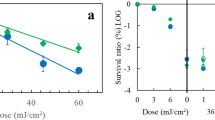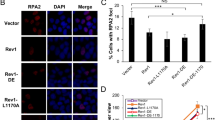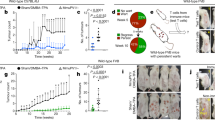Abstract
BACTERIA possess enzyme systems for repairing in the dark the damage caused by ultraviolet irradiation1 in which damaged regions of DNA are excised and replaced3. Damage to an infecting phage can also be repaired. This capacity, known as host cell reactivation (HCR), is manifested by the lowered survival of ultraviolet irradiated phages in radiation-sensitive mutant host bacteria3,4. Mammalian cells also possess repair systems. In xeroderma pigmentosum, a genetic disease associated with unusually high sensitivity to sunlight and a greatly increased susceptibility to carcinomas and melanomas of the skin, the capacity of fibroblast cells for repair is much lower than that of normal fibroblasts5. Recent evidence suggests that xeroderma pigmentosum cells are defective in the first reaction of the DNA repair mechanism2,6. Previous investigations have raised the possibility of a host cell reactivation system in mammalian cells7–13. We have shown directly that normal human cells have HCR capacity by comparing the ultraviolet sensitivities of two viral functions of the DNA tumour virus SV40—transformation and T-antigen induction—in normal and xeroderma pigmentosum cells.
This is a preview of subscription content, access via your institution
Access options
Subscribe to this journal
Receive 51 print issues and online access
$199.00 per year
only $3.90 per issue
Buy this article
- Purchase on Springer Link
- Instant access to full article PDF
Prices may be subject to local taxes which are calculated during checkout
Similar content being viewed by others
References
Setlow, R. B., Prog. Nucleic Acid Res. Mol. Biol., 8, 257 (1968).
Cleaver, J. E., Proc. US Nat. Acad. Sci., 63, 428 (1969).
Ellison, S. A., Feiner, R. R., and Hill, R. F., Virology, 11, 294 (1960).
Rörsch, A., Kamp, C. van der, and Adema, J., Biochim. Biophys. Acta, 80, 346 (1964).
Cleaver, J. E., Nature, 218, 652 (1968).
Setlow, R. B., Regan, J. D., German, J., and Carrier, W. L., Proc. US Nat. Acad. Sci., 64, 1035 (1969).
Rabson, A. S., Tyrrell, S. A., and Legallais, F. Y., Proc. Soc. Exp. Biol. Med., 132, 802 (1969).
Blacklow, N. R., Hoggan, M. D., and Rowe, W. P., J. Exp. Med., 125, 755 (1967).
Eb, A. J. van der, and Cohen, J. A., Biochem. Biophys. Res. Commun., 28, 284 (1967).
Bishop, J. M., Quintrell, N., and Koch, G., J. Mol. Biol., 24, 125 (1967).
Zavadova, Z., Giestrand, L., and Rosenbergova, M., Acta Virol., 12, 515 (1968).
Jansz, H. S., Pouwels, P. H., and Rotterdam, C. van., Biochim. Biophys. Acta., 76, 655 (1963).
Yarus, M., and Sinsheimer, B. L., J. Mol. Biol., 8, 614 (1964).
Black, P. H., Ann. Rev. Microbiol., 22, 391 (1968).
Todaro, G. J., Green, H., and Swift, M. B., Science, 153, 1252 (1966).
Aaronson, S. A., J. Virol., 6, 393 (1970).
Pope, J. H., and Rowe, W. P., J. Exp. Med., 120, 124 (1964).
Aaronson, S. A., and Todaro, G. J., Virology, 36, 254 (1968).
Rupert, C. S., and Harm, W., Adv. Rad. Biol., 2, 1 (1966).
Author information
Authors and Affiliations
Rights and permissions
About this article
Cite this article
AARONSON, S., LYTLE, C. Decreased Host Cell Reactivation of Irradiated SV40 Virus in Xeroderma Pigmentosum. Nature 228, 359–361 (1970). https://doi.org/10.1038/228359a0
Received:
Issue Date:
DOI: https://doi.org/10.1038/228359a0
This article is cited by
-
Epstein–Barr virus latent membrane protein 1 induces micronucleus formation, represses DNA repair and enhances sensitivity to DNA-damaging agents in human epithelial cells
Oncogene (2004)
-
Human cell transformation by simian virus 40—A review
In Vitro (1981)
-
Human brain tumour cell strains with deficient host-cell reactivation of N-methyl-N′-nitro-N-nitrosoguanidine-damaged adenovirus 5
Nature (1979)
Comments
By submitting a comment you agree to abide by our Terms and Community Guidelines. If you find something abusive or that does not comply with our terms or guidelines please flag it as inappropriate.



